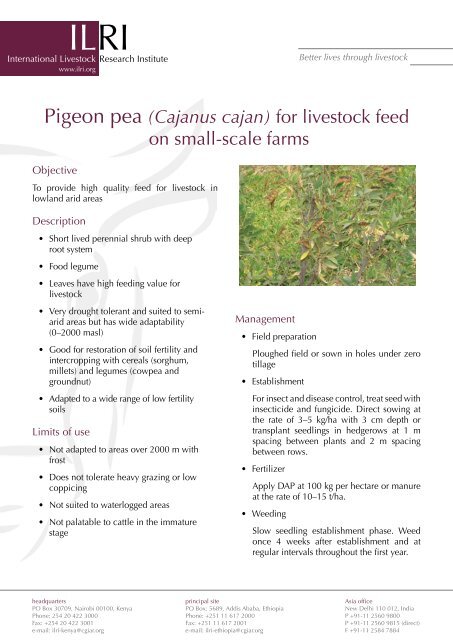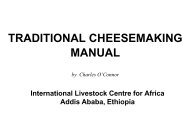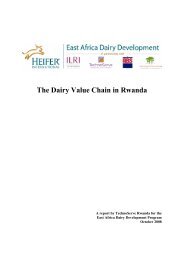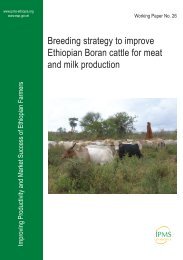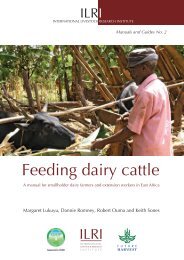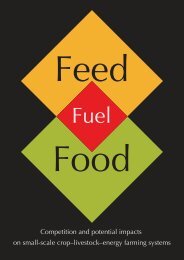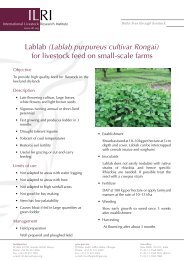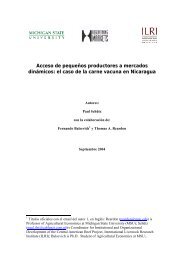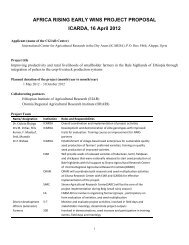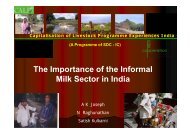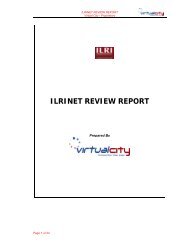Pigeon pea (Cajanus cajan) for livestock feed on small-scale farms
Pigeon pea (Cajanus cajan) for livestock feed on small-scale farms
Pigeon pea (Cajanus cajan) for livestock feed on small-scale farms
You also want an ePaper? Increase the reach of your titles
YUMPU automatically turns print PDFs into web optimized ePapers that Google loves.
ILRI<br />
Internati<strong>on</strong>al Livestock Research Institute<br />
www.ilri.org<br />
headquarters<br />
PO Box 30709, Nairobi 00100, Kenya<br />
Ph<strong>on</strong>e: 254 20 422 3000<br />
Fax: +254 20 422 3001<br />
e-mail: ilri-kenya@cgiar.org<br />
principal site<br />
PO Box: 5689, Addis Ababa, Ethiopia<br />
Ph<strong>on</strong>e: +251 11 617 2000<br />
Fax: +251 11 617 2001<br />
e-mail: ilri-ethiopia@cgiar.org<br />
Better lives through <str<strong>on</strong>g>livestock</str<strong>on</strong>g><br />
<str<strong>on</strong>g>Pige<strong>on</strong></str<strong>on</strong>g> <str<strong>on</strong>g>pea</str<strong>on</strong>g> (<str<strong>on</strong>g>Cajanus</str<strong>on</strong>g> <str<strong>on</strong>g>cajan</str<strong>on</strong>g>) <str<strong>on</strong>g>for</str<strong>on</strong>g> <str<strong>on</strong>g>livestock</str<strong>on</strong>g> <str<strong>on</strong>g>feed</str<strong>on</strong>g><br />
<strong>on</strong> <strong>small</strong>-<strong>scale</strong> <strong>farms</strong><br />
Objective<br />
To provide high quality <str<strong>on</strong>g>feed</str<strong>on</strong>g> <str<strong>on</strong>g>for</str<strong>on</strong>g> <str<strong>on</strong>g>livestock</str<strong>on</strong>g> in<br />
lowland arid areas<br />
Descripti<strong>on</strong><br />
•<br />
•<br />
•<br />
Short lived perennial shrub with deep<br />
root system<br />
Food legume<br />
Leaves have high <str<strong>on</strong>g>feed</str<strong>on</strong>g>ing value <str<strong>on</strong>g>for</str<strong>on</strong>g><br />
<str<strong>on</strong>g>livestock</str<strong>on</strong>g><br />
• Very drought tolerant and suited to semiarid<br />
areas but has wide adaptability<br />
(0–2000 masl)<br />
• Good <str<strong>on</strong>g>for</str<strong>on</strong>g> restorati<strong>on</strong> of soil fertility and<br />
intercropping with cereals (sorghum,<br />
millets) and legumes (cow<str<strong>on</strong>g>pea</str<strong>on</strong>g> and<br />
groundnut)<br />
•<br />
Adapted to a wide range of low fertility<br />
soils<br />
Limits of use<br />
•<br />
•<br />
•<br />
•<br />
Not adapted to areas over 2000 m with<br />
frost<br />
Does not tolerate heavy grazing or low<br />
coppicing<br />
Not suited to waterlogged areas<br />
Not palatable to cattle in the immature<br />
stage<br />
Management<br />
•<br />
•<br />
•<br />
•<br />
Field preparati<strong>on</strong><br />
Ploughed field or sown in holes under zero<br />
tillage<br />
Establishment<br />
For insect and disease c<strong>on</strong>trol, treat seed with<br />
insecticide and fungicide. Direct sowing at<br />
the rate of 3–5 kg/ha with 3 cm depth or<br />
transplant seedlings in hedgerows at 1 m<br />
spacing between plants and 2 m spacing<br />
between rows.<br />
Fertilizer<br />
Apply DAP at 100 kg per hectare or manure<br />
at the rate of 10–15 t/ha.<br />
Weeding<br />
Slow seedling establishment phase. Weed<br />
<strong>on</strong>ce 4 weeks after establishment and at<br />
regular intervals throughout the first year.<br />
Asia office<br />
New Delhi 110 012, India<br />
P +91-11 2560 9800<br />
P +91-11 2560 9815 (direct)<br />
F +91-11 2584 7884
•<br />
•<br />
•<br />
Harvesting<br />
Cut at 0.8 m after grain harvest. <str<strong>on</strong>g>Pige<strong>on</strong></str<strong>on</strong>g> <str<strong>on</strong>g>pea</str<strong>on</strong>g><br />
does not persist if heavily grazed and can<br />
be harvested twice per year under rainfed<br />
c<strong>on</strong>diti<strong>on</strong>s.<br />
Per<str<strong>on</strong>g>for</str<strong>on</strong>g>mance<br />
It grows well intercropped with Rhodes<br />
grass (Chloris gayana), Star grass (Cynod<strong>on</strong><br />
dactyl<strong>on</strong>) and Mollasses grass (Melinis<br />
minutiflora). Under grazing c<strong>on</strong>diti<strong>on</strong>s, it<br />
makes vigorous growth during the first year<br />
and then declines and it usually requires<br />
replanting every 4 to 5 years. Expect 10–<br />
15 t<strong>on</strong>nes dry matter per hectare per year<br />
increasing to 20 t<strong>on</strong>nes per hectare with<br />
applicati<strong>on</strong> of fertilizer. Leaf material has<br />
high nutritive value and palatability and<br />
generally has crude protein levels of 10–<br />
15%.<br />
Seed producti<strong>on</strong><br />
Most of the seed pods are picked by hand in<br />
the tropics. The seed pods ripen irregularly<br />
and do not shatter easily. Seed yield is about<br />
900–1500 kg/ha.<br />
In<str<strong>on</strong>g>for</str<strong>on</strong>g>mati<strong>on</strong> leaflet <strong>on</strong> <str<strong>on</strong>g>livestock</str<strong>on</strong>g> <str<strong>on</strong>g>feed</str<strong>on</strong>g>s and <str<strong>on</strong>g>feed</str<strong>on</strong>g>ing<br />
technologies <str<strong>on</strong>g>for</str<strong>on</strong>g> <strong>small</strong>-<strong>scale</strong> farmers developed through<br />
collaborati<strong>on</strong> between ILRI and its partners<br />
June 2010<br />
•<br />
Utilizati<strong>on</strong><br />
The grain is used <str<strong>on</strong>g>for</str<strong>on</strong>g> human food and also<br />
<str<strong>on</strong>g>for</str<strong>on</strong>g> <str<strong>on</strong>g>livestock</str<strong>on</strong>g>. Straws, husks and screenings<br />
are useful roughages. Allow the plants to<br />
develop well be<str<strong>on</strong>g>for</str<strong>on</strong>g>e grazing and then lightly<br />
graze to a hedge at the desired height. The<br />
plant stems are brittle and easily broken, so<br />
grazing should not be c<strong>on</strong>tinuous. <str<strong>on</strong>g>Pige<strong>on</strong></str<strong>on</strong>g><br />
<str<strong>on</strong>g>pea</str<strong>on</strong>g> is harvested <str<strong>on</strong>g>for</str<strong>on</strong>g> hay. Harvest not more<br />
than the upper third of the plant to avoid<br />
the woody base. Also, <str<strong>on</strong>g>Pige<strong>on</strong></str<strong>on</strong>g> <str<strong>on</strong>g>pea</str<strong>on</strong>g> hay is<br />
an effective substitute <str<strong>on</strong>g>for</str<strong>on</strong>g> more expensive<br />
industrial c<strong>on</strong>centrates. Feed it al<strong>on</strong>g with<br />
low quality roughages to improve their<br />
utilizati<strong>on</strong> and to increase protein intake. It<br />
can be made into silage, can be used as a<br />
cut-and-carry <str<strong>on</strong>g>feed</str<strong>on</strong>g> and is palatable.<br />
For further in<str<strong>on</strong>g>for</str<strong>on</strong>g>mati<strong>on</strong>, c<strong>on</strong>tact:<br />
Fodder Adopti<strong>on</strong> Project<br />
fodderadopti<strong>on</strong>.wordpress.com<br />
Forage Diversity Project<br />
Internati<strong>on</strong>al Livestock Research Institute,<br />
PO Box 5689, Addis Ababa, Ethiopia<br />
Email: a.duncan@cgiar.org or j.hans<strong>on</strong>@cgiar.org


